| |
Walk Cranstons Trail Middle Dural - Saturday 23 October
Jennifer Farrer
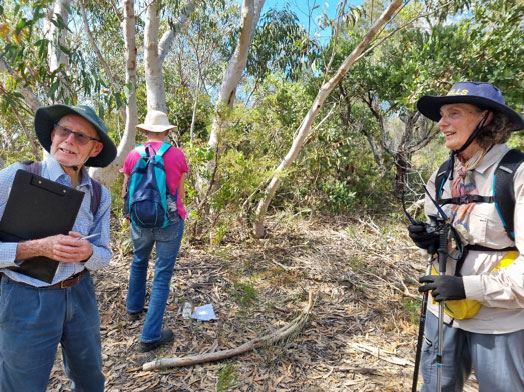
This was our first face-to-face activity after the easing of restrictions. Members were obviously keen to get out and about, as there were 22 of us on the walk.
The Cranstons Trail goes from the end of Cranstons Road Middle Dural to O’Hara’s Creek, a tributary of Cattai Creek. The vegetation is typical of the Hawkesbury sandstone flora. Our group walked the ridgeline to the point where the trail starts to plunge into the valley. In this relatively short distance, the eagle eyes of our members identified 61 species. A full list appears in the Resources section of our website. So, I will just mention some of the highlights:
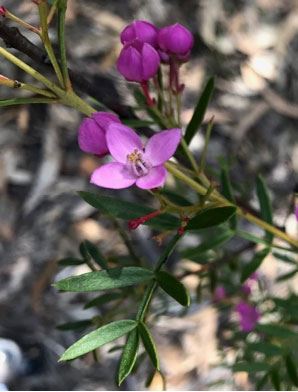 - Several Angophora hispida in bud at the start of the walk. This very scruffy-looking small tree has the most beautiful deep burgundy flower buds. The prominent hairs on the buds and stems give it its name. Hispida means hairy in Latin.
- We saw two plants that were new to most members. A small wattle Acacia hispidula, which was identified by its distinctive seed pods and the hairs on the leaves and stems - there is that Latin word again. Then on the other side of the path the only prostrate Dodonaea in the Sydney region, Dodonaea camfieldii with its prominent seeds.
-
Several stands of tall Boronia pinnata.
Boronia pinnata. Photo Lesley Waite
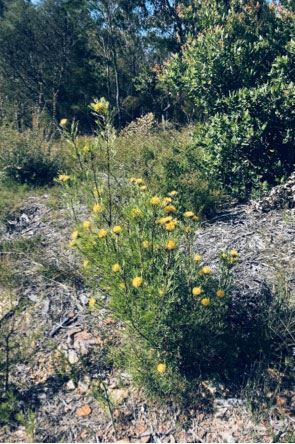 - Clumps of Isopogon anemonifolius all bursting with yellow flowers.
-
Many Kunzea capitata plants with their distinctive terminal pink flowers. There were also many bushes of the more common Kunzea ambigua in flower.
-
Philotheca buxifolia in flower. This is not seen in many places locally.
-
One sighting of the rare Darwinia biflora. Rare because it only occurs in parts of north and north-west Sydney.
This was our last walk for this year. We will be out again next year when the summer is over.
Isopogon anemonifolius. Photo Lesley Waite
ZOOM Meeting - Friday Sep 24, 2021Topic: How We survived LockdownThe following PowerPoint Presentations were used for our Zoom meeting. PowerPoint Download Link: Jean and Alan Wrights Garden
PowerPoint Download Link: How We survived Lockdown View Garden 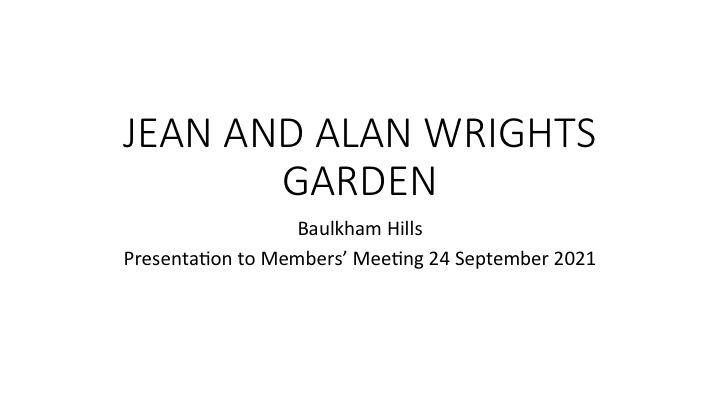
View Lockdown 
BUSHWALK along QUARRY ROAD FIRE TRAIL June 2O21On 26th June thirteen members collected at the end of Quarry Road, Dural, on a fine, cool afternoon. From there the Quarry Road fire trail extends to Berowra Creek in the Eloura Bushland, not that any of our walks would go that far. There is too much to see and admire along this sandy ridge top. This ridge supports a huge number of plant species. Being before midwinter, we did not expect to see as many flowers, and we were pleased to see more than expected. This trail is known for its banksias and B. marginata, B. spinulosa and B. ericifolia lit up the roadside bush. Flowers were seen on many other species; such as Acacia ulicifolia and A. suaveolens, Woollsia pungens, Epacris pulchella, Grevillea speciosa and Bossiaea heterophylla. Others were in full bud, such as Bossiaea scolopendria, Grevillea buxifolia and Phyllota phylicoides. Tony Maxwell had provided a list of likely species prepared from internet sites like ALA (Atlas of Living Australia). We added many more to the list. This walk was a very good exercise in the recognition of native plants from foliage appearances and form. It was greatly enjoyed by all our very observant members. Plants Identified on the Walk
| *Acacia longifolia | Dampiera stricta | Lambertia formosa F | | *Acacia myrtifolia F | Darwinia biflora | eptospermum trinervium | | Acacia suaveolens F | Dianella prunina | kucopogon mircophyllus F | | Acacia ulicifolia F | Dillwynia elegans | Lindsaea line | | Actinotus helianthi | *Dodonea triquetra | Lindsaea microphylla | | Actinotus minor F | *Drosera peltata | Lomatia silaifolia | | Allocasuarina littoralis | Epacris pulchella F | Micrantheum ericoides | | Angophora costata | Eucalyptus haemastoma | Mitrasacme polymorpha | | Angophora hispida | *Eucalyptus sclerophylla | *Monocota scoparia | | Banksia ericifolia F | Gomphlobium grandiflorum | Patersonia sericea | | Banksia marginata | *Gompholobium minor F | Persoonia levis F | | Banksia oblongifolia | Grevillea buxifolia F | Persoonia pinifolia | | Banksia serrata | Grevillea speciosa F | Petrophile pulchella | | Banksia spinulosa F | Hakea dactyloides | Phyllota phylicoides F | | Bossiaea heterophylla F | Hakea gibbose F | Platysace linearifolia | | Bossiaea scolopendria | Hakea propinqua | Tetratheca ericifolia F | | Cassinia denticulate | Hakea sericea | *Thelymitra ixioides | | Caustis flexuosa | *Isopogon anemonifolius | Woollsia Pungens F | | *Caustis pentandra | *Isopogon anethifolius | Xanthorrhhoea media | | Ceratopetalum gummiferum | *Kunsea ambigua | | | Conospermum longifolium F | *Gompholobium glabratum | | | Corymbia gummifera | | and one fungus: | | Crowea exalata | | Rimaria strictus |
* Denotes not on computer list for Quarry Road
F = some flowers seen
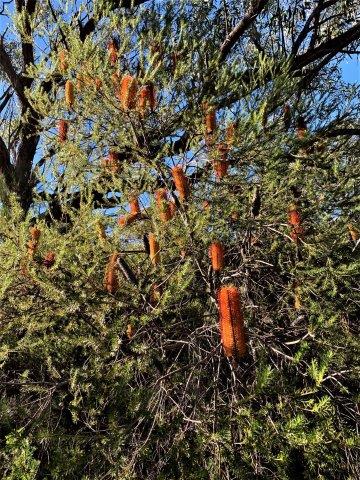  Banksia ericifolia Acacia myrtifolia Banksia ericifolia Acacia myrtifolia
.jpg)
Banksia marginata 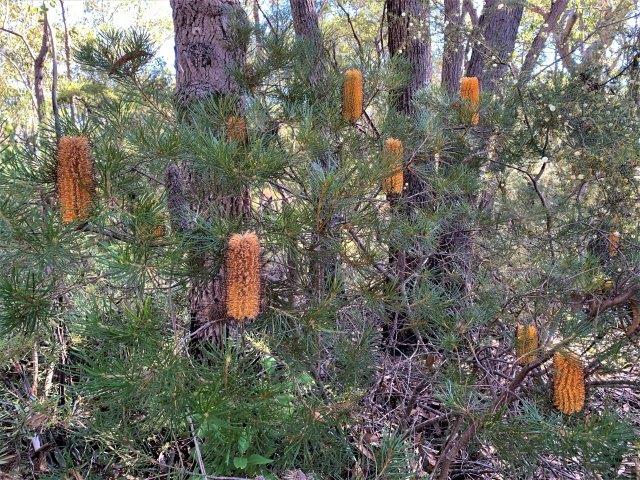
Banksia spinulosa

Grevillea speciosa

Hakea gibbosa
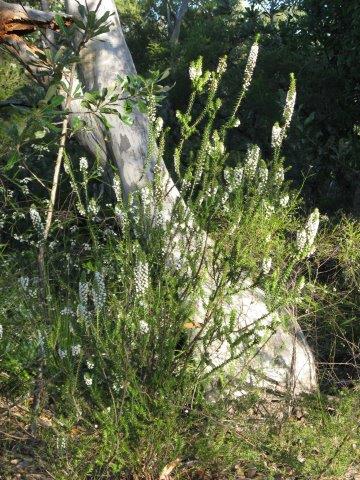
Woolsia pungens
Propagation Workshop led by Lesley Waite - 22 May 2021

Thank you, Lesley Waite, for your wonderful presentation at our May meeting about plant propagation by cuttings.
Lesley told us how to collect cutting material, how to prepare the cuttings, the best types of potting media to use, and how to set up a system at home that would give cuttings the best chance of ‘striking’.
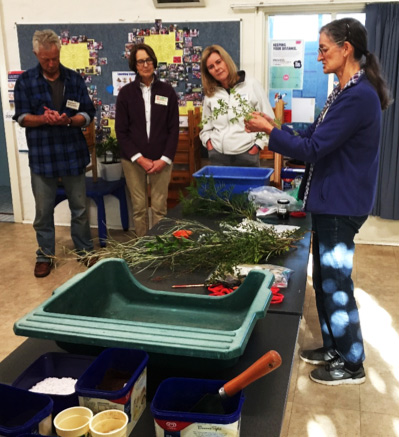
The demonstration was full of interest and information. It was interactive, with many comments and suggestions coming from the keen and attentive audience gathered around the table.
One of the key takeaway points was that everyone’s system and requirements are unique, and if something works for you, keep
Lane Cove Bushland Park walk - Saturday 24 April 2021Jennifer Farrer 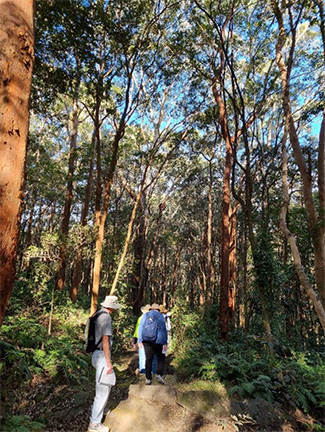 Eleven Parra Hills members gathered for this walk in an amazing pocket of bushland only 10 kilometres from the Sydney CBD. The park is very small (9 hectares) and is mostly covered by warm temperate wet sclerophyll forest. In some sections only 10% of sunlight reaches the understorey. The park is very steep and surrounded by urban areas. You are completely unaware of the houses in the surrounding streets once you descend into the gully. The gully flows into Gore Creek which flows into Sydney Harbour less than one kilometre from the park. Eleven Parra Hills members gathered for this walk in an amazing pocket of bushland only 10 kilometres from the Sydney CBD. The park is very small (9 hectares) and is mostly covered by warm temperate wet sclerophyll forest. In some sections only 10% of sunlight reaches the understorey. The park is very steep and surrounded by urban areas. You are completely unaware of the houses in the surrounding streets once you descend into the gully. The gully flows into Gore Creek which flows into Sydney Harbour less than one kilometre from the park.
We decided to visit the park because we had heard Ray Kearney give a talk about the fungi in the park at one of our meetings in 2019. His observations in the park had led to the discovery of fungi from the Hygrophoraceae family particularly the Hygrocybe species.
We did find fungi on the walk but not the rare species. Quite a few specimens were looking a bit dessicated as there had not been any rain for quite a few days. Ron Gornall, one of our members who lives in Lane Cove and has been to the reserve with Ray Kearney pointed out the area where the fungi occurred near the creek and warned us that they are very small. | Omphalotus nidiformis (Ghost Fungus): | a colourful lichen on bark: |  | 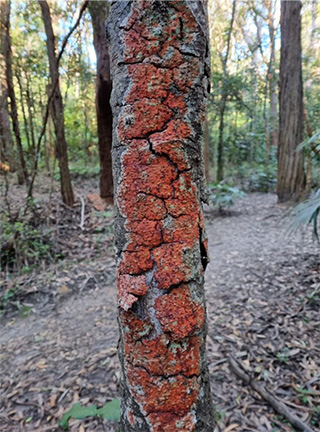 |
However, there were plenty of other interesting plants to see. Many ferns flourish in the moist shady environment. I was particularly fascinated by one of the ground ferns, Hypolepis muelleri , which creeps over rocks with very slender rhizomes. Most of our walks are in the local Hawkesbury sandstone country so it was a challenge for us to see so many rainforest plants. Fortunately we have members who were able to help with the identification of these species. Some of these were Cabbage Tree Palms (Livistona australis), Native Guava (Eupomatia laurina) with fruits, creepers such as Smilax australis, Tylophora barbata, Geitonoplesium cymosum and Native Passionfruit (Passiflora herbertiana). Tony Maxwell again prepared plant lists for the walk and we were able to add some additional species to these lists. (see Resources page)
VISIT to BONGALA GARDENS in KENTHURST - 27 March 2021
On a sunny afternoon in March, twelve members of ParraHills APS group visited Boongala Gardens. This is an amazing native garden created over many years by Mal and Jenny Johnston. The land was previously totally-cleared farming land, and the transformation required a huge amount of work. A large variety of native plants are featured, growing on raised elongated mounds. Visitors meander along sinuous grass areas, each corner revealing a new combination of plants. Being autumn, most were not in flower, but there was some colour particularly from the multitude of grafted grevilleas, Banksia spinulosa and Hibiscus germanioides. Grevillea ‘Golden Lyre’ was in full bloom, and many others had some flowers. Interestingly this garden exhibits many of the older, no-longer-sold hybrids discussed by Peter Olde in the recent online talk. For example, Grevillea ‘Ivory Whip’ was flowering well. There is no need for masses of flowers to make a garden interesting, not if you have bottle trees, Eucalyptus ficifolia covered in large gumnuts, and specimens of Dorianthes excelsa with huge flower spikes. Scattered around the garden are old farm implements, rusting sedately. Mal is very interested and knowledgeable about early Australian history. He has constructed a little slab hut displaying more historic wares, convict bricks, photos and so forth. He also has hives of native, stingless bees. 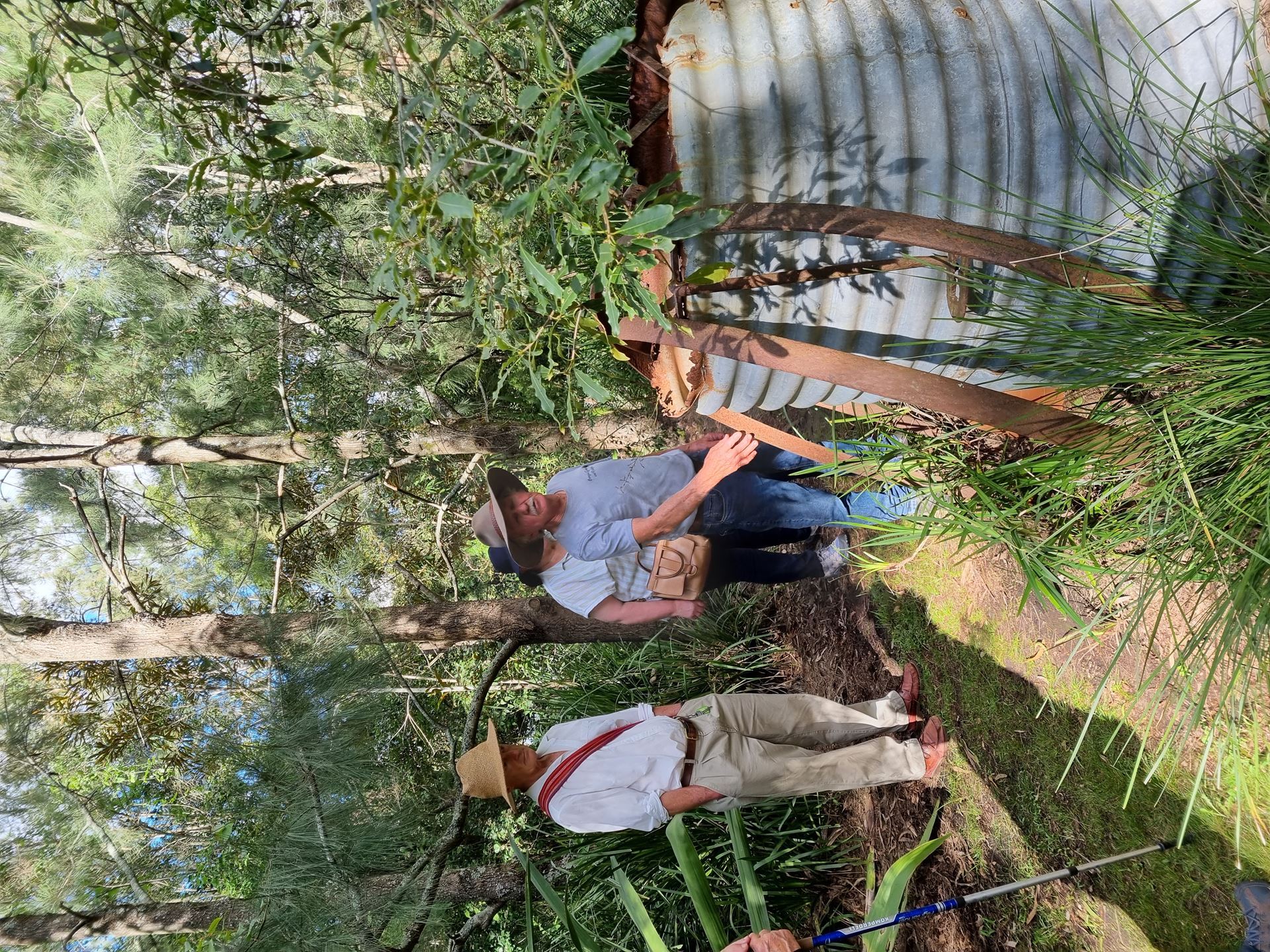 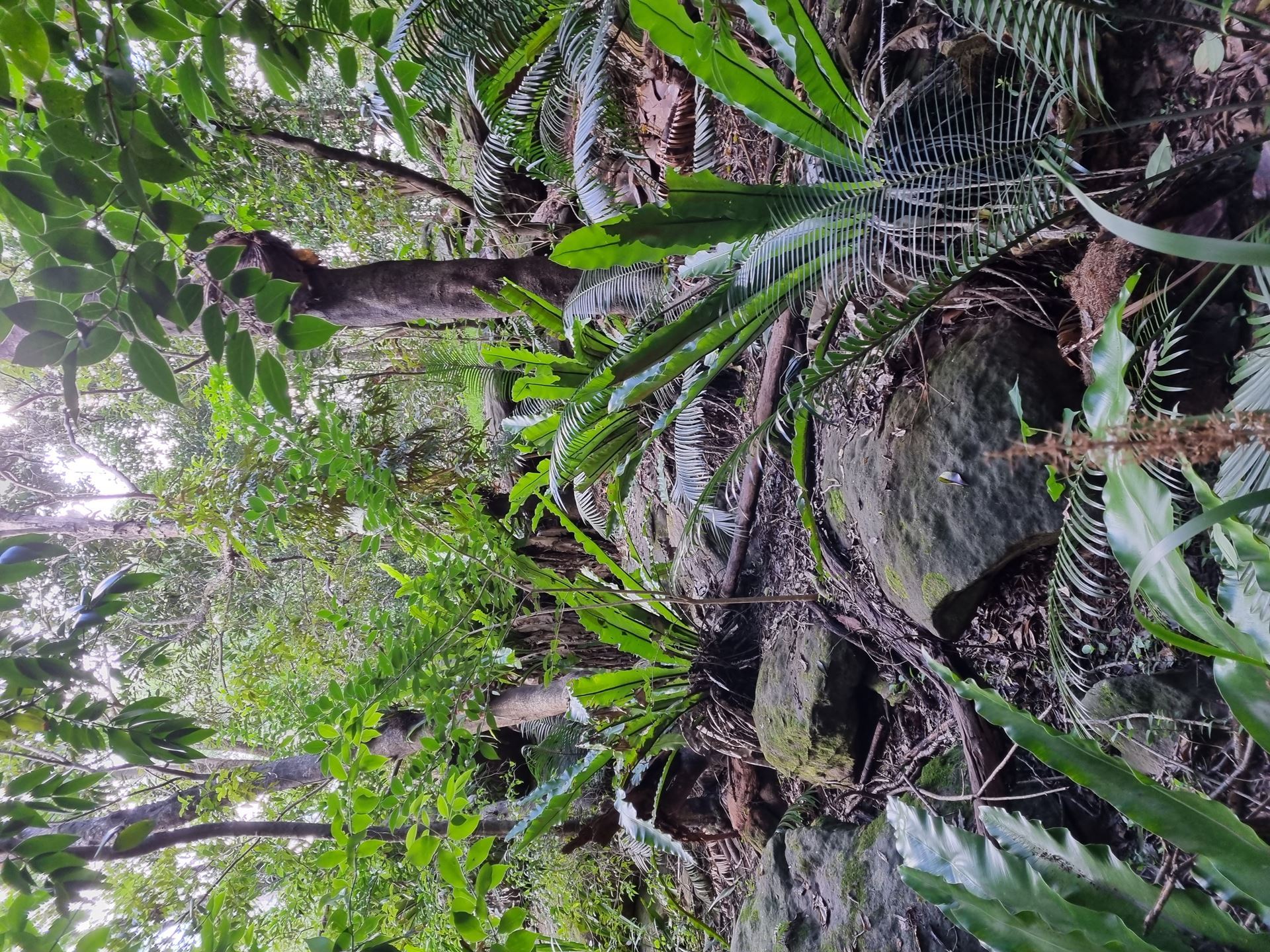
After a break and afternoon tea, Mal took us for a walk through their rainforest, planted on the slope behind the gardens. Many of the trees are over 30 years old, and again there is a huge variety, along with ground covers, ferns and orchids. All this time, Jenny was serving in their shop. In the past Mal and Jenny ran a native plant nursery, Annangrove Grevilleas. They again sell plants during their open garden times. Obviously, the group browsed and purchased there, before we went home. Look out for the opportunity to visit this magnificent garden. Their next open season will be in spring 2021.

SYMBIOTIC RELATIONSHIP between NATIVE WOODLANS PLANTS and NATIVE WOODLAND BIRDS - 27 Feb 2021

Australian King Parrot [male] at nest hole Woodford 22/07/2020
On Saturday 27th February Doug Meredith gave ParraHills a very interesting and informative talk with the above tittle. He concentrated on the Cumberland Plain, a large area of fairly flat land between Windsor and Picton, and the Nepean River and the inner west suburbs of the city, excluding higher ground such as the Hills District. Most of the remaining uncleared land is dry sclerophyll woodland. For the birds, vegetation supplies shelter, food, water, roosts, nesting sites and nesting material. For the plants, birds act as pollinators, disperse seed and help with insect pest control.
Shelter is provided by dense foliage in which birds can hide, or spikey foliage through which little birds can fly but their larger predators can’t. The wings of many small birds are different from those of larger birds, and allow the little birds to accurately fly through thickets of branches. Shelter can be by camouflage when the bird’s colourings are very similar to the foliage. Quail can hide in long grass and be very hard to see, because their speckled colouring perfectly matches the patchy grass colours.
Nectar feeding birds have long thin beaks to reach into flowers for nectar. As they do, the flower’s pollen falls onto the feathers of the head and elsewhere. When the bird goes to another flower some pollen falls onto that flower’s stigma, and the flower is fertilised. So the bird feeds and the plant’s flowers are fertilised at the same time. Other birds eat seeds and fruit. The seeds pass through the birds and are deposited elsewhere, along with a suitable dollop of fertiliser to aid a young plant’s growth. Mistletoe provides shelter for the mistletoe bird, which also eat the mistletoe fruit. The seed has a sticky substance on it which makes some seed stick to the bird’s beak. Later the bird tends to rub off the seed on a tree branch elsewhere. That bird also has a digestive system, through which the seeds pass very rapidly, and remain viable. Larger birds like the yellow-tailed black cockatoo have strong beaks which can crack open the hard casuarina fruit to access the seed. Birds also get water from trees, especially in the early mornings when dew drips off the leaves. Water also collects in the forks between branches. Some acacias have glands on their leaves containing a sugary liquid and birds can access this, particularly the nectar-feeding birds.
Insect-feeding birds are very important to plants to reduce plant damage from insects. Birds eat lerps, caterpillars, aphids, and flying insects like moths, flies and bees. Some birds catch their prey on the wing. Others, such as a tree-creeper, hop along a tree trunk, probing cracks and crevices in the bark for insects. Others can tear off strips of bark to find insects beneath. Most birds feed insects to their young offspring in the nest. Large birds like black cockatoos have sharp strong beaks with which they tear into branches to find wood borers. How the bird can accurately detect just where in a branch it will find a borer is not yet understood.

Grey Fantail
Most birds nest in trees where height above the ground gives increased protection from predators. Nesting materials include bark, moss, leaves and twigs, grass, roots, cobwebs, mud and feathers. Most birds chose a nest site very carefully. Many have nests which blend in with the surrounds, and often the colouring on the bird’s head and back is good camouflage making them harder to spot by predatory carnivorous birds, while they are sitting on their eggs. Some species nest on hollows on old growth trees. It can take 100 years for a tree to have hollows created when dead limbs fall. This is why retaining old-growth forest is so important for birds, and why replanting trees will not adequately replace old trees for a very long time. In most species the male finds a suitable nesting hollow and then will call and/or display to advertise it, trying to attract a female partner. Nest boxes are not adequate replacements for tree hollows, as they lack the insulation provided by a tree branch. Eggs and nestlings are very sensitive to changes in temperature and easily killed if the nest is not insulated adequately.
Doug’s talk was crammed with specific and very interesting information. We now know that the lady yellow-tailed black cockatoo is more heavily coloured than her male mate, having a splash of bright yellow on her head. This is most unusual in birds. In all except a small number of species, it is the male which is the more brightly coloured.
Native Plants for Pots and Containers 27-06-20
 On 27th June we had our first group meeting via Zoom. Our guest speaker was Brian Roach, from Westleigh Native Plants. With decreasing size of house blocks and increasing numbers of people living in units and retirement villages, this topic is very relevant. It is also possible to grow some of the difficult-to-grow species in a pot because you can control the growing environment more easily than for plants in the ground. There is the chance to grow some of the desirable Western Australian species. Having plants in pots means that you can move them around, to take advantage of sun and light, or move them out of the strongest sun in summer. You can also move that beautiful plant in full flower to a spot where you can see it better and show it off to visitors. Maybe a difficult plant can be left where you can check on it easily and control the watering more closely. There are other containers you can use instead of pots, eg lengths of old clay piping left over from a plumbing job. These can be partly buried to stabilise them. On 27th June we had our first group meeting via Zoom. Our guest speaker was Brian Roach, from Westleigh Native Plants. With decreasing size of house blocks and increasing numbers of people living in units and retirement villages, this topic is very relevant. It is also possible to grow some of the difficult-to-grow species in a pot because you can control the growing environment more easily than for plants in the ground. There is the chance to grow some of the desirable Western Australian species. Having plants in pots means that you can move them around, to take advantage of sun and light, or move them out of the strongest sun in summer. You can also move that beautiful plant in full flower to a spot where you can see it better and show it off to visitors. Maybe a difficult plant can be left where you can check on it easily and control the watering more closely. There are other containers you can use instead of pots, eg lengths of old clay piping left over from a plumbing job. These can be partly buried to stabilise them.
Crowea saligna
Brian had some practical advice about pots. He especially warned us to avoid the urn-shaped pots which curve in at the top. The curve makes it almost impossible to tip the plant out in order to repot it when it outgrows its pot. He advocated purchasing a native pot mix then adding perlite and cocopeat. Some plants have larger root systems and eventually outgrow any pot. They need to be pensioned off or planted in the garden if appropriate. In general the smaller growing plants are the most suitable.
During the talk Brian showed great photos of the plants he has grown in pots. These included Pimelea linifolia, both Crowea exalata and saligna, some boronias and Lechanaultia biloba with its brilliant blue flowers. The latter demonstrates that pot culture can be successful for this prized Western Australian plant, which regularly dies in the ground in Sydney. Other species he featured were Darwinia taxifolia ssp macrolaena, the native Rhododendron viriosum (formally R. lochiae), Billardia leumanniana and Conostylis aurea. The last two species are also examples of floriferous Western Australian plants. Brian has registered some new names with the Australian Cultivar Authority for different and desirable variants of some species. One example is Homoranthus prolixus ‘Golditops’ which has masses of brilliant gold flowers. This form was found in northern NSW. More recently he has named a natural hybrid between Grevillea fililoba and hirtella found by Peter Olde in Western Australia. He called this small plant Grevillea ‘Butterfly Beauty” because the flowers look like crimson butterflies in the bush.
As usual Brian was an interesting and very knowledgeable speaker, much appreciated by those who logged in via Zoom.
Pip Gibian

Rhododendron viriosum
|







 Banksia ericifolia Acacia myrtifolia
Banksia ericifolia Acacia myrtifolia.jpg)






 Eleven Parra Hills members gathered for this walk in an amazing pocket of bushland only 10 kilometres from the Sydney CBD. The park is very small (9 hectares) and is mostly covered by warm temperate wet sclerophyll forest. In some sections only 10% of sunlight reaches the understorey. The park is very steep and surrounded by urban areas. You are completely unaware of the houses in the surrounding streets once you descend into the gully. The gully flows into Gore Creek which flows into Sydney Harbour less than one kilometre from the park.
Eleven Parra Hills members gathered for this walk in an amazing pocket of bushland only 10 kilometres from the Sydney CBD. The park is very small (9 hectares) and is mostly covered by warm temperate wet sclerophyll forest. In some sections only 10% of sunlight reaches the understorey. The park is very steep and surrounded by urban areas. You are completely unaware of the houses in the surrounding streets once you descend into the gully. The gully flows into Gore Creek which flows into Sydney Harbour less than one kilometre from the park.








